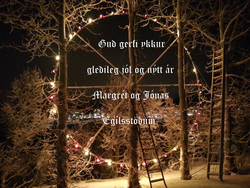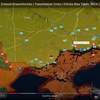Höfundur

Gleðileg Jól frá
Egilsstöðum.
24.12.2023,
slóð,
,
Hver selur peningaprentunina, peningabókhaldið til einstaklinga, sem þykjast svo lána fólkinu og ríkinu.
Hringurinn - Tveir jólasveinar? - Jólin 2023
![]() Við erum að reyna að bjarga okkur öllum, og líka okkur gömlu svindlurunum.
Við erum að reyna að bjarga okkur öllum, og líka okkur gömlu svindlurunum.
Alls ekki sprengja upp veröldina, heilmyndina, háskóla leikritið sem við erum leikendur í.
![]() Notum aðferðirnar hans Mandela og klárum kennslu leikritið, heilmyndina öllum til sóma og látum Karlinn með skeggið um dóminn.
Notum aðferðirnar hans Mandela og klárum kennslu leikritið, heilmyndina öllum til sóma og látum Karlinn með skeggið um dóminn.
Það er búið að hringla í tölvunni minni í geymslu diskum og bloggunum á netinu. Sum bloggin eru röng, og koma með annarra skoðanir.
Egilsstaðir, 11.10.2023 Jónas Gunnlaugsson
Velt vöngum, Ef eitthvað er hér sem er til upplýsingar, og til góðs, þá er um að gera að dreifa því sem víðast. Við verðum að læra um fjármálin og breyta svo fjármálakerfinu.
hitt bloggið, slóðin er hér neðan við, bloggin eru tvö,
the path to the other blog is here
000
https://jonasg-egi.blog.is/blog/jonasg-egi/entry/2255795/
000
Nikola Tesla var einn af þeim, sem fluttu þjóðunum blessun og leystu fólkið úr ánauð þekkingarleysisins? Þekkingin skapar allsnæktir. Nústaðreyndatrúin stóð á móti Jesú og Nikola Tesla. Við skulum færa Jesú og Tesla aftur inn í skólanna. 20.12.2017 | 18:24 Viðtal við Nikola Tesla 1899
English
24.11.2017 | 22:09
31.8.2018 | 09:28
000
English
7.10.2017 | 13:26
***
Hér er eðlisfræði lífsins 1. 2. 3.
------Jóhannesarguðspjall, Kafli 14, vers 6------
----Velt vöngum um Bíblíuna. Tönn fyrir tönn. Fyrirgefning fyrir fyrirgefningu. EINFALT----
28.12.2017 | 10:06
Þessa slóð verður að lesa.
Learn, learn, learn. Læra, læra, læra.
This link you must read.
My homepage:
![]() hitt bloggið hér neðan við, bloggin eru tvö
hitt bloggið hér neðan við, bloggin eru tvö
http://jonasg-egi.blog.is/blog/jonasg-egi/image/1298552/
![]()
Og það besta, ég lánaði þér ekki neitt.
MYNDIN SEM VIÐ LIFUM Í HOLOGRAMINU ER AÐEINS TIL Í HUGSKOTI OKKAR.
Verum fulltrúar gnægta, lausna.
*--- Spuni ---*
****
****
****
**![]() ** Fjármálakerfið er einfalt, ekki láta flækja það til að blekkja okkur. **
** Fjármálakerfið er einfalt, ekki láta flækja það til að blekkja okkur. **![]() **
**
The Two Step Plan - Nýtt peningakerfi. Eg. 07.12.2011 jg
****
Nýtt peningakerfi. Eg. 07.12.2011 jg
Islam frá árinu 700 til 2015, mjög fróðlegt.
Það er eins og við getum ekki sagt í orðum, hvert vandamálið er.
**
Skapararnir og Nú staðreynda trúar fólkið.
**
**
**
Íbúðalánasjóður, láttu ekki plata þig.
****
****
Nótur, kvittanir, peningur er færanlegt bókhald.
****
Israel, 29.01.2009. endurtekið
****
**** **** ****
**** **** ****
Israel, 29.01.2009. endurtekið
Snúðu jörðinni og stækkaðu eða minnkaðu með músinni.
Ný nú mynd kemur upp þegar þú endurræsir, ýtir á refresh, (F5).
****
****
Glenna --
Pottur --
MUNA --
********
MUNA, bankar græddu ekkert. --
********
Gerð --
ooo
Mikil blessun Jesaja 9:1-20 ---
****
Bólur, "KLIKK, PIKK, BRELLA, BRELLA."
****
Try to understand the money masters
We must learn a " New World Order "
Peningar eru flutningabílar. ----
Fjármálakerfið, fjárfestar, tæmdu fésýslufyrirtækin -----
****
ENGLISH -
Paper money -- (Stjórnarskrá - peningana -- Constitution - Of money jg) ----
Central-banks ----
Try to understand the money masters
Learn, learn, learn. Læra, læra, læra.
ENGLISH
http://www.herad.is/y04/1/2011-10-05-Central-banks-05.htm
****
****
Verum fulltrúar gnægta, lausna.
**** **** ****
**** **** ****
---- SJÓÐUR "0"
Af hverju talar engin um "KREPPUFLÉTTUNA."------**![]() **Ríkisstjórnin**
**Ríkisstjórnin**![]() ** - -----Kreppufléttan 2013 og miðbankinn--------Kreppu, verðbólgu, verðhjöðnunar fléttan------Getum við skilið hvernig spilað er með okkur?------Jóhannesarguðspjall, Kafli 14, vers 6---- 12 Year Old Girl Paints Heaven, Unbelievable! ---- Hér er sýnishorn af sálum sem eru að koma í stórum stíl inn í "mannheima" til að kenna okkur hinum.---- http://www.youtube.com/watch?v=Xzq4PHJoItU---- Fluga á vegg.----Eignirnar----Kreppufléttan, læra---- Thomas Jefferson sagði okkur þetta allt saman. ----Miscellaneous, Ýmislegt----Dept is slavery Go to the dot “.”Money As Debt The deptindustry It's Not a Deficit, It's New Money ----Ríkisstjórnin----Kosningamálin verða.----icesave-2 - Hótun----Skuldir einkabankanna----Fléttan ----Ámynning - Eignirnar færðar úr fasteigninni yfir í töluna sem bankinn skrifaði í tölvuna hjá sér. ---- Loftpeningar ----Þú elskar að láta plata þig. ----Miðríkið----Merkilegt ----Mjög merkilegt, peningaleikur. ----"Arðurinn" eru eigur fólksins, eigur heimilanna, eigur atvinnuveganna ---- MUNA ----Bóndabær----Restoring our Financial Sovereignty A New Monetary System----Einfalt peningakerfi.----www.herad.is ----http://www.ismennt.is/not/jonasg/jg/jg06/----http://www.herad.is/y04/1/----
** - -----Kreppufléttan 2013 og miðbankinn--------Kreppu, verðbólgu, verðhjöðnunar fléttan------Getum við skilið hvernig spilað er með okkur?------Jóhannesarguðspjall, Kafli 14, vers 6---- 12 Year Old Girl Paints Heaven, Unbelievable! ---- Hér er sýnishorn af sálum sem eru að koma í stórum stíl inn í "mannheima" til að kenna okkur hinum.---- http://www.youtube.com/watch?v=Xzq4PHJoItU---- Fluga á vegg.----Eignirnar----Kreppufléttan, læra---- Thomas Jefferson sagði okkur þetta allt saman. ----Miscellaneous, Ýmislegt----Dept is slavery Go to the dot “.”Money As Debt The deptindustry It's Not a Deficit, It's New Money ----Ríkisstjórnin----Kosningamálin verða.----icesave-2 - Hótun----Skuldir einkabankanna----Fléttan ----Ámynning - Eignirnar færðar úr fasteigninni yfir í töluna sem bankinn skrifaði í tölvuna hjá sér. ---- Loftpeningar ----Þú elskar að láta plata þig. ----Miðríkið----Merkilegt ----Mjög merkilegt, peningaleikur. ----"Arðurinn" eru eigur fólksins, eigur heimilanna, eigur atvinnuveganna ---- MUNA ----Bóndabær----Restoring our Financial Sovereignty A New Monetary System----Einfalt peningakerfi.----www.herad.is ----http://www.ismennt.is/not/jonasg/jg/jg06/----http://www.herad.is/y04/1/----
Nýjustu fćrslur
- Hér er hćgt ađ fá ađ vita heilmikiđ um ţađ ""hvađ varđ um pen...
- Ef allir lćra um bókhaldiđ, peningaprentunina og styđja stjór...
- Er heimurinn loks búinn ađ missa vitiđ? Úkrainu stríđiđ hóf...
- " Viđ erum komin nálćgt ţví ađ búa til svokölluđ krabbameinsb...
- Göng beint á Seyđisfjörđ og beint á Mjóafjörđ, áfram beint á ...
- Ţađ vćri nánast "ómögulegt" ađ stöđva ţróun gervigreindar og ...
- Valgerđur tók lyfiđ Ivermectin, til ađ forđast Covid-19, lćkn...
- Ítrekuđ alvarleg atvik vegna hćlisleitenda í Fjölbrautarskóla...
- Alls ekki svara ţótt hent sé kjarnorku sprengjum, heldur reyn...
- Ert ţú syndlaus, villt ţú ekki hlusta á ţann góđa? Hér er ath...
- Nýlega kom hinsvegar í ljós í forklínískum rannsóknum ađ engi...
- Ţetta upphlaup gagnvart Ráđfrúnni er til ađ viđ gleymum ađ fj...
- Verđur ađ skilja, ađ leiđandi Bolsjevíkar, sem tóku yfir Rúss...
- How the Russian soul can save the American Empire - If we don...
- Munum ađ fortíđin, nútíminn og framtíđin eru nú, allt er í h...
Eldri fćrslur
2024
2023
2022
2021
2020
2019
2018
2017
2016
2015
2014
2013
2012
Apríl 2024
Heimsóknir
Flettingar
- Í dag (20.4.): 0
- Sl. sólarhring: 4
- Sl. viku: 98
- Frá upphafi: 0
Annađ
- Innlit í dag: 0
- Innlit sl. viku: 72
- Gestir í dag: 0
- IP-tölur í dag: 0
Uppfćrt á 3 mín. fresti.
Skýringar
Mystery of 2,000-year-old Roman concrete solved by scientists
... Some 2,000 years after they were first erected, Ancient Roman harbours made from concrete are still standing across Europe. ...
... Concrete used for ancient sea walls was made by mixing lime, seawater, volcanic ash and rock. The combination produces a 'possolanic reaction' – named after the commune of Pozzuoli in Naples.
Researchers have now discovered that elements in the ash react with sea water, which actually strengthens the material. ...
... Romans created a rock-like concrete that thrives in open chemical exchange with seawater,"...
...
Researchers discovered the Roman concrete contained aluminium tobermorite, a rare mineral that adds extra strength. When the Roman concrete was exposed to seawater, the tobermorite crystallised and spread.
The researchers said that long-term exposure to sea water helped these crystals to continue growing, reinforcing the concrete and preventing cracks from developing. ...
000
Egilsstađir, 05.07.2017 Jónas Gunnlaugsson




 Bloggar | Slóđ | Facebook | Athugasemdir (0)
Bloggar | Slóđ | Facebook | Athugasemdir (0)





